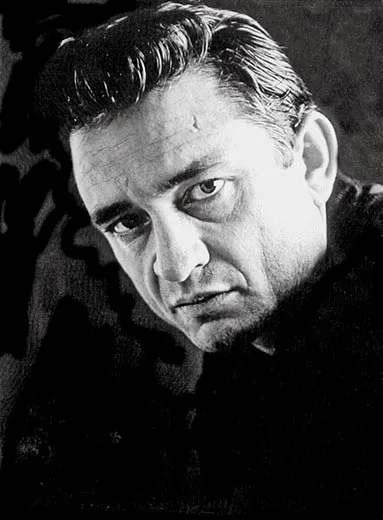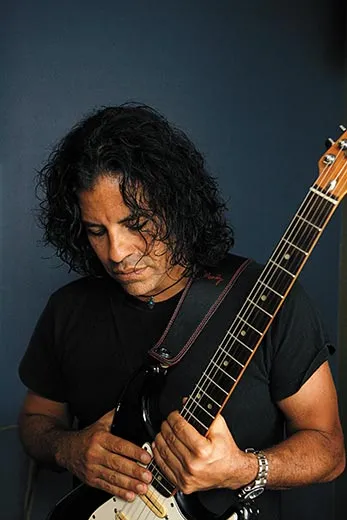The Pop Charts’ Native Roots
From country music ballads to rock power chords, Native Americans left a lasting impression on the soundtrack of the 20th century
/https://tf-cmsv2-smithsonianmag-media.s3.amazonaws.com/filer/Unsung-Heroes-Apache-guitarist-Stevie-Salas-631.jpg)
“I look at you all, see the love there that’s sleeping, while my guitar gently weeps,” George Harrison sang to a packed audience at the 1971 Concert for Bangladesh in Madison Square Garden. A stoic Eric Clapton trailed with a wailing guitar lick. Leon Russell pounded the keys in the background.
A fourth figure appears in the video at the National Museum of the American Indian: supporting guitarist Jesse Ed Davis. Though he is the least-known musician onstage, with his muscular build he seems to tower over the rest.
“If Clapton was known as God, then Jesse Ed Davis was right up there with the disciples somewhere,” says musician and contributing curator Stevie Salas, 47, who is posing for photographs at the ribbon-cutting ceremony for the museum’s new exhibition, “Up Where We Belong: Native Musicians in Popular Culture.”
With his mane of curly black hair, aviator sunglasses, green electric guitar and bright purple sneakers, Salas (Apache), who began his own career playing guitar with funk maestro George Clinton, embodies more of a rocker aesthetic than his fellow Native musician Jesse Ed Davis ever did. Yet Davis, who died in 1988, was the on-call supporting guitarist for some of the biggest names in American music, including Jackson Browne, Albert King, Willie Nelson and British imports such as Clapton and Rod Stewart.
Like Davis, many of the musicians featured in the exhibit had an impact on 20th-century music that far exceeded their fame. For instance, Shawnee guitarist Link Wray, who composed the 1958 instrumental song “Rumble,” invented the reverberating power chord—which later became the signature sound for such bands as Led Zeppelin and The Who.
While some musicians—including Jimi Hendrix and Rita Coolidge—reached stardom without publicizing their indigenous roots, others found inspiration in their heritage. Peter La Farge, a 1950s and ’60s folk singer and descendant of Narragansett Indians, composed songs protesting the contemporary struggles of Native Americans. Johnny Cash—who had already achieved stardom with his number one country music hit “Ring of Fire”—developed an interest in Native American issues and recorded La Farge’s songs in a 1964 album Bitter Tears. When radio stations refused to play it on grounds that it was too political, an outraged Cash (who was not Native American) took out an ad in Billboard declaring, “Where are your guts?”
Buffy Sainte-Marie’s “Up Where We Belong”—the exhibition’s title—won a 1983 Academy Award for best original song, from the movie An Officer and a Gentleman. Born on a Cree reservation in Canada, Sainte-Marie helped start a foundation for Native American education. Her repertoire also includes protest songs such as “Now That the Buffalo’s Gone” and “Bury My Heart at Wounded Knee.”
In addition to gazing at photographs, videos and pop culture artifacts (such as Jimi Hendrix’s iconic patchwork coat), museumgoers can listen to a soundtrack featuring the works of exhibition musicians. Amid the diverse sounds of rock, pop, country, soul, heavy metal and funk, Salas detects a common element: “Every one of those musicians had a real sense of rhythm,” he says. “They seemed to share a common rhythmic thread that worked and blended with all kinds of music, from pop, rock, R&B and country.”
Indeed, Salas’ success as a musician has a lot to do with his versatility. “You could ask: What do Justin Timberlake, Rod Stewart, George Clinton and Mick Jagger have in common?” he says. “And you’d say Stevie Salas. They have an Apache Indian in common.”
Yet, Salas adds, “I was never the guy up there with my eagle feather tied to my guitar neck. That’s for me and my family. That’s for when I come home. When I’m out there onstage, I think of myself as a global world artist, a citizen of the whole planet.”
And he says he hopes the exhibit will convey to a younger generation of Native musicians that global success is possible. “I’ve had kids tell me, ‘I want to do what you’re doing, but they won’t let us.’ And I say to them, ‘Well who are they? Because they let me.’”
/https://tf-cmsv2-smithsonianmag-media.s3.amazonaws.com/accounts/headshot/jess-righthand-240.jpg)



/https://tf-cmsv2-smithsonianmag-media.s3.amazonaws.com/accounts/headshot/jess-righthand-240.jpg)